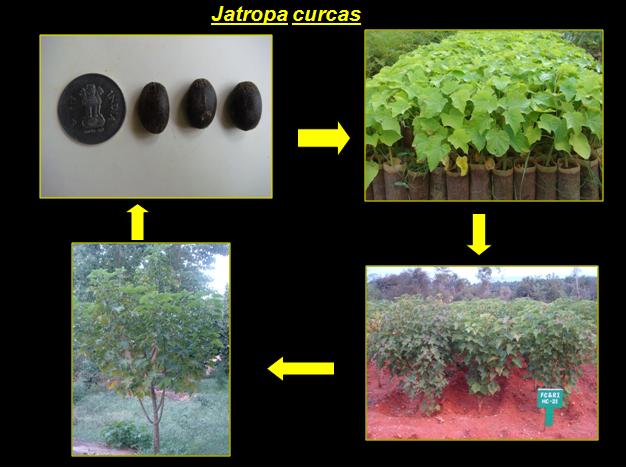
|
||
| Home | About Forestry | Eco-Tourism | Forestry Addresses | FAQs | Contact Us | Disclaimer | |
||
| Industrial Forestry | ||
BIOFUEL SPECIES
Scientific name: Jatropha curcas Family: Euphorbiacea Origin: It is multipurpose non-edible oil yielding perennial shrub originated in tropical America. Special Features: Hardy and drought tolerant and non-browsable and latex producing plant. The oil from J. curcas can be used as biodisel blend upto 20%. Rotation: Economically maintained upto 30 years Climate: It grows well under subtropical and tropical climates. It can tolerate extremes of temperature but not frost. Soil: It is grown in wide range of soils. It comes up in the marginal land and also in problem soil. Propagation: Jatropha is normally propagated through seeds. Well developed plumpy seeds are used for sowing. Germinated seeds are sown in poly bags of 10 x 20 cm size filled with red soil / sand and farmyard manure in the ratio of 1:1:1 respectively. Planting of Jatropha: - In one acre 1000 plants can be planted - Spacing: 2 m x 2m Pits: 30 cm3 may be dug and filled with soil and organic (5 kg FYM+ 100 g Neem cake + 100 g super) per pit be fore planting. Planting time: Monsoon season (June-July, October-November) Manures and fertilizer: 20: 120: 60 kg of NPK / acre in 2nd year onwards applied during September-October Irrigation: Fortnight interval After care: Weeding may be attended Canopy Management: The terminal growing twig is to be pinched to induce secondary branches. Likewise the secondary and tertiary branches are to be pinched or pruned at the end of first and second year to induce a minimum of 25 branches at the end of third year. Yield: 9 months after sowing the seedling produce flowering and 3rd year onwards the economic yield started. We obtain 500 kg – 1000 kg / seed per acre under rain fed Plant protection : Pest (Bark eater) and collar rot disease; Drenching with cropper oxyzhloride controls the collar rot disease. Uses: The seeds of jatropha is the chief source for biofuel production and also has medicinal uses. |
||
| Home | About Forestry | Eco-Tourism | Forestry Addresses | FAQs | Contact Us | Disclaimer |
© All Rights Reserved. TNAU-2016 |
||
